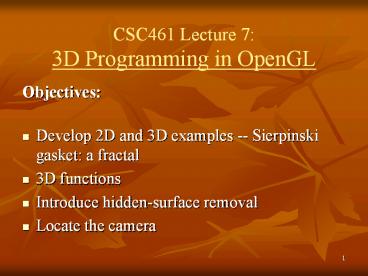CSC461%20Lecture%207:%203D%20Programming%20in%20OpenGL - PowerPoint PPT Presentation
Title:
CSC461%20Lecture%207:%203D%20Programming%20in%20OpenGL
Description:
Develop 2D and 3D examples -- Sierpinski gasket: a fractal. 3D functions ... The gasket as a fractal ... 3D Gasket. We can subdivide each of the four faces ... – PowerPoint PPT presentation
Number of Views:381
Avg rating:3.0/5.0
Title: CSC461%20Lecture%207:%203D%20Programming%20in%20OpenGL
1
CSC461 Lecture 73D Programming in OpenGL
- Objectives
- Develop 2D and 3D examples -- Sierpinski gasket
a fractal - 3D functions
- Introduce hidden-surface removal
- Locate the camera
2
Three-dimensional Applications
- In OpenGL, two-dimensional applications are a
special case of three-dimensional graphics - Not much changes
- Use glVertex3( )
- Have to worry about the order in which polygons
are drawn or use hidden-surface removal - Polygons should be simple, convex, flat
3
Sierpinski Gasket (2D)
- Start with a triangle
- Connect bisectors of sides and remove central
triangle - Repeat
4
Example
- Four subdivisions
5
The gasket as a fractal
- Consider the filled area (black) and the
perimeter (the length of all the lines around the
filled triangles) - As we continue subdividing
- the area goes to zero
- but the perimeter goes to infinity
- This is not an ordinary geometric object
- It is neither two- nor three-dimensional
- It has a fractal (fractional dimension) object
6
Gasket Program
- include ltGL/glut.hgt
- / a point data type
- typedef GLfloat point22
- / initial triangle /
- point2 v-1.0, -0.58, 1.0, -0.58, 0.0,
1.15 - int n / number of recursive steps /
7
Draw a triangle
- void triangle( point2 a, point2 b, point2 c)
- / display one triangle /
- glBegin(GL_TRIANGLES)
- glVertex2fv(a)
- glVertex2fv(b)
- glVertex2fv(c)
- glEnd()
8
Triangle Subdivision
- void divide_triangle(point2 a, point2 b, point2
c, int m) - / triangle subdivision using vertex numbers /
- point2 v0, v1, v2
- int j
- if(mgt0)
- for(j0 jlt2 j) v0j(ajbj)/2
- for(j0 jlt2 j) v1j(ajcj)/2
- for(j0 jlt2 j) v2j(bjcj)/2
- divide_triangle(a, v0, v1, m-1)
- divide_triangle(c, v1, v2, m-1)
- divide_triangle(b, v2, v0, m-1)
- else(triangle(a,b,c))
- / draw triangle at end of recursion /
9
Display and Init Functions
- void display(void)
- glClear(GL_COLOR_BUFFER_BIT)
- divide_triangle(v0, v1, v2, n)
- glFlush()
- void myinit()
- glMatrixMode(GL_PROJECTION)
- glLoadIdentity()
- gluOrtho2D(-2.0, 2.0, -2.0, 2.0)
- glMatrixMode(GL_MODELVIEW)
- glClearColor (1.0, 1.0, 1.0,1.0)
- glColor3f(0.0,0.0,0.0)
10
main Function
- int main(int argc, char argv)
- n4
- glutInit(argc, argv)
- glutInitDisplayMode
- (GLUT_SINGLEGLUT_RGB)
- glutInitWindowSize(500, 500)
- glutCreateWindow(2D Gasket")
- glutDisplayFunc(display)
- myinit()
- glutMainLoop()
11
Moving to 3D
- We can easily make the program three-dimensional
by using - typedef Glfloat point33
- glVertex3f
- glOrtho
- But that would not be very interesting
- Instead, we can start with a tetrahedron
12
3D Gasket
- We can subdivide each of the four faces
- Appears as if we remove a solid tetrahedron from
the center leaving four smaller tetrahedtra
13
Example
After 4 interations
14
triangle code
- void triangle( point a, point b, point c)
- // right-hand rule
- glBegin(GL_POLYGON)
- glVertex3fv(a)
- glVertex3fv(b)
- glVertex3fv(c)
- glEnd()
15
subdivision code
- void divide_triangle(point a, point b, point c,
int m) - point v1, v2, v3
- int j
- if(mgt0)
- for(j0 jlt3 j) v1j(ajbj)/2
- for(j0 jlt3 j) v2j(ajcj)/2
- for(j0 jlt3 j) v3j(bjcj)/2
- divide_triangle(a, v1, v2, m-1)
- divide_triangle(c, v2, v3, m-1)
- divide_triangle(b, v3, v1, m-1)
- else(triangle(a,b,c))
16
tetrahedron code
- void tetrahedron( int m)
- glColor3f(1.0,0.0,0.0)
- divide_triangle(v0, v1, v2, m)
- glColor3f(0.0,1.0,0.0)
- divide_triangle(v3, v2, v1, m)
- glColor3f(0.0,0.0,1.0)
- divide_triangle(v0, v3, v1, m)
- glColor3f(0.0,0.0,0.0)
- divide_triangle(v0, v2, v3, m)
17
Problem
- Because the triangles are drawn in the order they
are defined in the program, the front triangles
are not always rendered in front of triangles
behind them
get this
want this
18
Solution Hidden-Surface Removal
- We want to see only those surfaces in front of
other surfaces - OpenGL uses a hidden-surface method called the
z-buffer algorithm that saves depth information
as objects are rendered so that only the front
objects appear in the image
19
Using the z-buffer algorithm
- The algorithm uses an extra buffer, the z-buffer,
to store depth information as geometry travels
down the pipeline - It must be
- Requested in main.c
- glutInitDisplayMode
- (GLUT_SINGLE GLUT_RGB GLUT_DEPTH)
- Enabled in init.c
- glEnable(GL_DEPTH_TEST)
- Cleared in the display callback
- glClear(GL_COLOR_BUFFER_BIT
- GL_DEPTH_BUFFER_BIT)
20
Default camera setting
- With default, camera is located at the origin and
oriented at the negative z-axes - If place a cube at the origin, only one side of
the cube is visible - Look at objects from
- different angles
- Move the objects
- Move the camera
- Example a cube
21
Locating the camera
- Position and orient the camera three inputs
- Eye, at, and direction up
- Camera is on Model-View mode
22
Set Viewing
- Glu function
- void gluLookAt(eyex, eyey, eyez, atx, aty, atz,
upx, upy, upz) - Set viewing -- example
- glMatrixMode(GL_MODELVIEW)
- glLoadIdentity()
- gluLookAt(1.0, 1.0, 1.0, 0.0, 0.0, 0.0, 0.0,
1.0, 0.0) - // Camera located at (1,1,1), oriented to the
origin, and directed up along y-axis
23
Code Display a cube
- void display()
- glClear(GL_COLOR_BUFFER_BIT)
- glMatrixMode(GL_MODELVIEW)
- glLoadIdentity()
- gluLookAt(1.0, 1.0, 1.0, 0.0, 0.0, 0.0, 0.0,
1.0, 0.0) - cube()
- glFlush()































